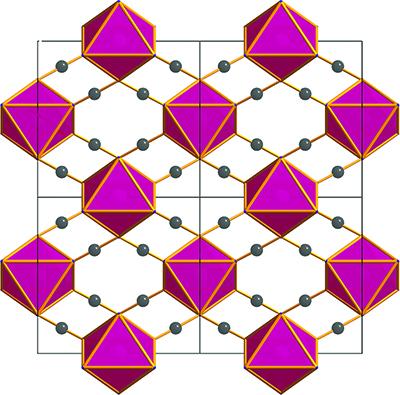Framework materials yield to pressure

This is a cobalt II octahedral packing diagram as viewed in the (001) plane. Credit: Yakovenko et al
Materials scientists can exploit the effectiveness of pressure for probing and tuning structural, mechanical, electronic, magnetic and vibrational properties of materials in situ; crystallography plays a crucial role, enabling on the one hand the unravelling of structural phenomena through a better understanding of interactions, and on the other shedding light on the correlation of structure and properties [Fabbiani (2015), Acta Cryst. B71, 247-249; doi: 10.1107/S2052520615009427].
With high pressure promoting effects such as magnetic crossover, spin transitions, negative linear compressibility, changes in proton conductivity, or even phase transitions that generate porous structures, high-pressure crystallographic studies on dense framework materials are on the rise.
More generally, coordination compounds are a fascinating class of materials for high-pressure crystallographic studies, compared with purely organic compounds; they have an inherent extra degree of flexibility for responding to moderate applied pressures, as the geometry at the metal centre can undergo marked changes, whereas other primary bond distances and angles remain largely unaffected.
A group of scientists [Yakovenko et al. (2015), Acta Cryst. B71, 252-257; doi: 10.1107/S2052520615005867] demonstrate that pressure offers a novel approach for generating new phases and exploring the structure-property relationships of molecular materials.
In their study the researchers present a high-pressure crystallographic study of α -Co(dca)2, including the structural determination of the high-pressure phase γ -Co(dca)2. The pressure-dependence of the atomic structure was probed within a diamond-anvil cell using synchrotron-based powder diffraction methods.
Future work from the group based at Argonne National Laboratory will involve investigations of the pressure-dependent structures of further transition metal dicyanamides, including members of the iso-structural α-MII(dca)2 family as well as other polymorphs, to uncover any universality or metal-ion dependence associated with the α?γ transition, and if other new phases can be generated.
Media Contact
All latest news from the category: Materials Sciences
Materials management deals with the research, development, manufacturing and processing of raw and industrial materials. Key aspects here are biological and medical issues, which play an increasingly important role in this field.
innovations-report offers in-depth articles related to the development and application of materials and the structure and properties of new materials.
Newest articles

Superradiant atoms could push the boundaries of how precisely time can be measured
Superradiant atoms can help us measure time more precisely than ever. In a new study, researchers from the University of Copenhagen present a new method for measuring the time interval,…

Ion thermoelectric conversion devices for near room temperature
The electrode sheet of the thermoelectric device consists of ionic hydrogel, which is sandwiched between the electrodes to form, and the Prussian blue on the electrode undergoes a redox reaction…

Zap Energy achieves 37-million-degree temperatures in a compact device
New publication reports record electron temperatures for a small-scale, sheared-flow-stabilized Z-pinch fusion device. In the nine decades since humans first produced fusion reactions, only a few fusion technologies have demonstrated…





















